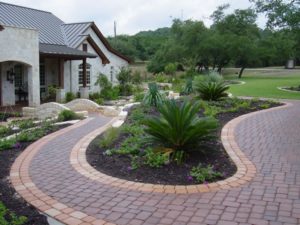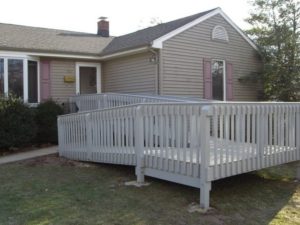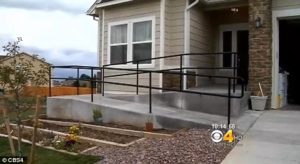Take a look at these 2 pictures below and tell me which one would you want?
Or
By the way, ramps are not just for wheelchairs. They are useful to everybody.
In fact, I just walked up a ramp the other day rather than taking the stairs.
Have you or a friend or family member had difficulty getting into your home? If so, maybe your entry-path could benefit from a ramp.
Ramps make homes accessible to people pushing strollers, to kids on bikes or scooters, to people in wheelchairs or on crutches, and for moving pieces of furniture or appliances easily in or out.
Ramp Design
The 2 kinds of ramps
- Integrated ramps (see top picture) look more natural and blend seamlessly into the landscaping. They are a welcoming way to reach your front door as they follow a natural gently sloping path. You can border them with lovely trees, shrubs and flowers to help blend them in.
- Structural ramps (see second picture) can have a tendency to look like an afterthought, and unfortunately that’s usually what they are. They are tacked onto a home in an area that has not been designed to contain a ramp.They can stick out like a sore thumb and bring down the curb-appeal of your home.
Ramp Slope
Ramps aren’t easy to build because they need to be designed with the correct slope and proper turns. Ramps are useful for overcoming changes in level up to 30in/76cm. Over this height things become more complicated as they require a lot of space, and so you may want to think about installing a lift instead.
It’s important to remember that the higher you need to go, the longer your ramp needs to be. You’ll need a minimum of 12in/30.5cm for every 1in/2.5cm in height (1:12). However, slopes that are less steep than 1:12 are easier to use. If you have the space for a ramp of 1:18 or 1:20 it would be a better choice, especially ones that you are integrating into the landscape.
Landings
Steep ramps are dangerous and difficult to use so it’s important to incorporate a landing every 20feet/6.1metres and every time a turn is made. This gives you a chance to take a break and rest partway up a ramp on a safe flat area. You also need to install a landing at the top and bottom of ramps. Landings should be 60in/152cm by 60in/152cm and door swings should not encroach on this area.
Continued in Part 2




